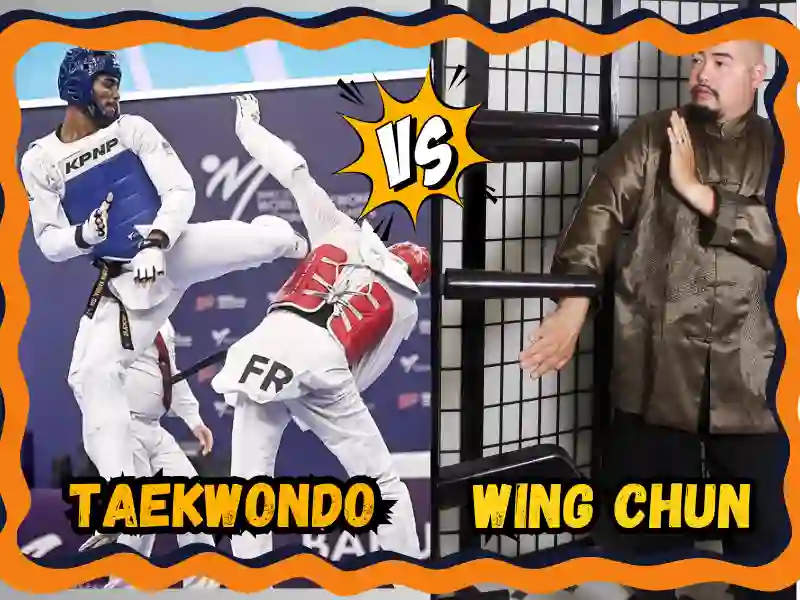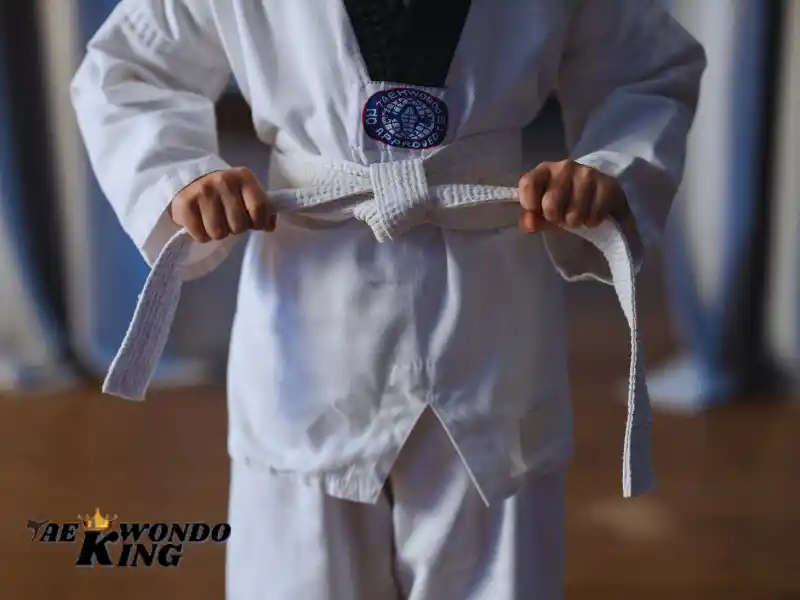
I am Ehatasamul Alom. I have finished a diploma program in Taekwondo, and I am a national and international athlete, instructor, holder of a 3rd Dan black belt, and national referee. Having much experience in Taekwondo martial arts has given me a thorough understanding of different martial arts disciplines. Taekwondo and Wing Chun are distinguished from other martial arts by their distinct techniques, philosophies, and histories. In this article, I will present a detailed analysis of (Taekwondo) TKD vs Wing Chun, showcasing their unique characteristics and commonalities.
Historical Background
Taekwondo:
Taekwondo originates from traditional Korean martial arts such as Taekkyeon and Subak, and translates to “the way of the foot and the hand.” General Choi Hong Hi was instrumental in the development of it during the mid-20th century when it was formalized. Taekwondo is famous for its energetic kicking techniques, impressive jumping kicks, and strong hand strikes. It has developed into a martial art and a competitive sport, becoming popular globally.
Wing Chun:
Wing Chun is a Chinese martial art developed during the Qing Dynasty, attributed to the legendary figures Ng Mui, a Shaolin Buddhist nun, and her disciple Yim Wing Chun. It emphasizes close-quarters combat, efficiency, and economy of movement. It is known for its direct strikes, trapping techniques, and centerline theory, making it a highly practical martial art for real-world self-defense scenarios.
Philosophical Foundations
Taekwondo Philosophy:
The principles that steer Taekwondo are Courtesy, Integrity, Perseverance, Self-Control, and Indomitable Spirit. These principles not only influence the practice of the martial art but inspire practitioners to embody them in their everyday lives. Taekwondo strives to enhance physical and moral strength, encouraging a balanced and disciplined way of life.
Wing Chun Philosophy:
The core principles of Wing Chun focus on being practical, simple, and efficient. It focuses on efficient movements that are straightforward and cost-effective, making sure that energy and movement are utilized efficiently. The central theory of Wing Chun is the centerline theory, which focuses on controlling and attacking along the centerline of the opponent’s body. This method encourages rapid, decisive responses in battle, demonstrating the art’s emphasis on practical self-protection.
Techniques and Training
Taekwondo Techniques:
Taekwondo is celebrated for its high, fast, and powerful kicks, such as the roundhouse kick, side kick, and spinning hook kick. It also incorporates hand techniques, including punches, blocks, and strikes. Training in Taekwondo involves practicing patterns (poomsae), sparring (kyorugi), and breaking techniques (kyokpa). Physical conditioning, flexibility, and endurance are essential components of Taekwondo training.
Wing Chun Techniques:
Wing Chun focuses on fighting at close range with fast, straight punches, trapping, and controlling maneuvers. Chain punches, palm strikes, and low kicks are essential techniques to master. Training in Wing Chun includes practicing forms like Siu Nim Tao, Chum Kiu, and Biu Jee, as well as sensitivity drills such as Chi Sao, and training with the wooden dummy. The emphasis is on velocity, accuracy, and management instead of sheer power.
Training Focus and Methodology
Taekwondo Training:
Taekwondo practice frequently focuses on the competitive sports aspect, specifically Olympic-style sparring. Traditional Taekwondo schools also emphasize forms (poomsae), which are a series of movements symbolizing defensive and offensive methods. Physical fitness in Taekwondo training relies on physical conditioning, flexibility, and endurance.
Wing Chun Training:
Wing Chun training prioritizes practical self-defense techniques, focusing on effectiveness in neutralizing potential threats. The practice involves Chi Sao drills to improve reflexes and tactile awareness, enabling practitioners to react instinctively to their opponent’s actions. Forms and wooden dummy training assist in honing techniques and enhancing accuracy.
Similarities Between TKD vs Wing Chun
- Discipline and Respect: Both Taekwondo and Wing Chun instill a strong sense of discipline and respect in their practitioners. These values are essential for creating a positive and respectful training environment and for fostering personal growth and ethical behavior.
- Self-Defense Focus: Both martial arts are effective self-defense systems, teaching practitioners how to protect themselves and respond to various threats. They enhance personal safety and confidence through practical techniques and strategies.
- Physical and Mental Development: Both Taekwondo and Wing Chun contribute to physical fitness, mental discipline, and personal growth. Practitioners develop strength, flexibility, coordination, and mental focus through consistent practice.
TKD vs Wing Chun Differences
Combat Range:
- Taekwondo: Emphasizes long-range techniques, particularly powerful, high, and fast kicks. Taekwondo’s combat approach is more linear and direct, focusing on speed and impact from a distance.
- Wing Chun: Focuses on close-quarters combat, utilizing quick, direct strikes, trapping, and control techniques. Wing Chun’s combat approach is more compact and efficient, designed for close-range encounters.
Technique Variety:
- Taekwondo: Specializes in striking techniques, with a particular emphasis on kicking. The variety of kicks in Taekwondo is extensive, showcasing the art’s focus on leg techniques.
- Wing Chun: Offers a range of techniques, including strikes, trapping, and control techniques. Wing Chun’s approach is more holistic, incorporating hand strikes, low kicks, and grappling elements.
Training Environment:
- Taekwondo: Training often includes competitive sparring, form practice, and breaking techniques. The environment is often oriented towards sport and competition, especially in schools that follow the Olympic style.
- Wing Chun: Training often simulates real-life self-defense scenarios, incorporating sensitivity drills and wooden dummy training. The environment is more focused on practical self-defense applications and refining technique precision.
Conclusion: Choosing Your Path
Taekwondo and Wing Chun provide distinct and beneficial methods for learning martial arts, each possessing its strengths and ideologies. Taekwondo is known for its dynamic and powerful kicks, which help improve physical fitness, encourage competitive sportsmanship, and foster a disciplined way of life. Wing Chun stands out as a very efficient and practical form of self-defense, focusing on close-range fighting, precision, and effectiveness.
As someone who has practiced and coached Taekwondo for many years, I recommend that people try out different martial arts to see which one suits their goals and interests. Whether you are looking for physical fitness, competitive chances, or practical self-defense abilities.
Taekwondo and Wing Chun provide fulfilling avenues to master martial arts. In the end, your decision on whether to pursue Taekwondo or Wing Chun should be driven by your goals, hobbies, and the principles you want to develop during your martial arts experience.
FAQs
What are the main differences between Taekwondo (TKD) and Wing Chun?
The primary distinctions between Taekwondo (TKD) and Wing Chun are found in their techniques and focal points. TKD places importance on strong, powerful kicks, energetic footwork, and athleticism, while also highlighting competitive sparring and forms (poomsae). On the flip side, Wing Chun emphasizes practicality and self-defense through close-quarters combat, quick strikes, trapping, and efficient movements.
Which Martial Art is more effective for self-defense, TKD or Wing Chun?
Many people believe that Wing Chun is superior for self-defense because it emphasizes close-range moves, rapid attacks, and the quick elimination of dangers. TKD is capable in self-defense scenarios needing powerful kicks and strikes but might be less useful in close-quarters combat when compared to Wing Chun.
How do the training methods of TKD and Wing Chun differ?
Training in Taekwondo often consists of thorough practice of kicks, forms, sparring, and conditioning exercises to enhance flexibility and strength. Training in Wing Chun emphasizes developing sensitivity through drills such as Chi Sao, utilizing strikes at close range, and learning practical self-defense techniques. Wing Chun focuses on efficient movement and straightforwardness.
TKD vs Wing Chun? Which Martial Art emphasizes kicking techniques more?
Taekwondo places a greater focus on kicking techniques compared to Wing Chun. TKD is famous for its emphasis on quick, forceful kicks, which play a key role in its training and competitions. Wing Chun involves a few kicking methods but focuses more on hand strikes and trapping techniques.
Can TKD and Wing Chun be practiced together?
Yes, it is possible to train in TKD and Wing Chun simultaneously, offering a comprehensive martial arts journey. TKD can improve kicking and athleticism, while Wing Chun can enhance close-range combat abilities and fast, effective striking. Nevertheless, careful management may be necessary to balance the various techniques and philosophies.
Which Martial Art is better for fitness, TKD vs Wing Chun?
TKD is usually more effective for overall physical health because of its intense workouts, such as dynamic kicks, sparring, and demanding conditioning drills. Wing Chun enhances fitness levels but prioritizes technique, efficiency, and practical self-defense over intense workouts.
How do the philosophies of TKD and Wing Chun differ?
The core of TKD’s philosophy focuses on building physical and mental discipline by undergoing strict training, engaging in competitions, and following principles like courtesy, integrity, perseverance, self-control, and indomitable spirit. Wing Chun’s beliefs prioritize simplicity, effectiveness, and straightforwardness in battle, emphasizing practical self-protection and the idea of using an adversary’s strength against them.
Which Martial Art is more suitable for children, TKD vs Wing Chun?
Taekwondo is commonly seen as a better option for kids because of its organized lesson plans, focus on health and fitness, and opportunities for young participants in programs and competitions. Children may find the active and interesting characteristics of TKD attractive. Wing Chun may also be appropriate for kids, particularly those keen on gaining practical self-defense skills, but it might necessitate a deeper grasp of close-range tactics.
How do belt ranking systems compare between TKD and Wing Chun?
TKD uses a formal belt ranking system to signify a practitioner’s progress and proficiency, typically starting with a white belt and advancing through various colored belts to a black belt. Wing Chun does not traditionally use a belt ranking system; progress is often measured by mastery of specific techniques and forms. However, some modern Wing Chun schools have adopted ranking systems for organizational purposes.
Which Martial Art has a stronger competitive aspect, TKD or Wing Chun?
Taekwondo has a stronger competitive aspect, with numerous regional, national, and international competitions, including the Olympics. Competitions focus on sparring, forms (poomsae), and breaking techniques. Wing Chun is less focused on competition and more on practical self-defense and personal development, with fewer organized tournaments.

Founder, Owner, and CEO of TaekwondoKing.
He is one of the top 100 martial artists in the World and among the top 20 referees in Bangladesh.
Ehatasamul Alom is an esteemed Kukkiwon Certified Taekwondo 3rd Dan Black Belt with over 15 years of experience in this dynamic martial art. Born in Rajshahi, Bangladesh, Ehatasamul’s journey with Taekwondo began at the tender age of seven. His passion led him to compete at national and international levels, where he has bagged numerous awards and honors. He is also a member of the Taekwondo National Referee Panel.
With a Bachelor’s degree in Sports Science from the prestigious Rajshahi University, Ehatasamul has a deep understanding of the technical and scientific aspects of martial arts and some other martial arts.
In 2022, Ehatasamul created the “TaekwondoKing.com” to share his knowledge, Free Resources, Values, and Real experiences. His articles focus on Taekwondo training techniques, competition strategies, Sport Products Reviews, and the art’s rich history and philosophy. He also writes about the importance of mental fortitude and discipline, key aspects of his teaching philosophy. He has already launched many sports, Taekwondo, and health-related Free online tools. His goal is to inspire both beginners and seasoned practitioners worldwide through insightful and engaging content.
If you need any help, contact Ehatasamul Alom at any time.





I was reading through some of your articles on this website and I conceive this internet site is real informative! Continue putting up.